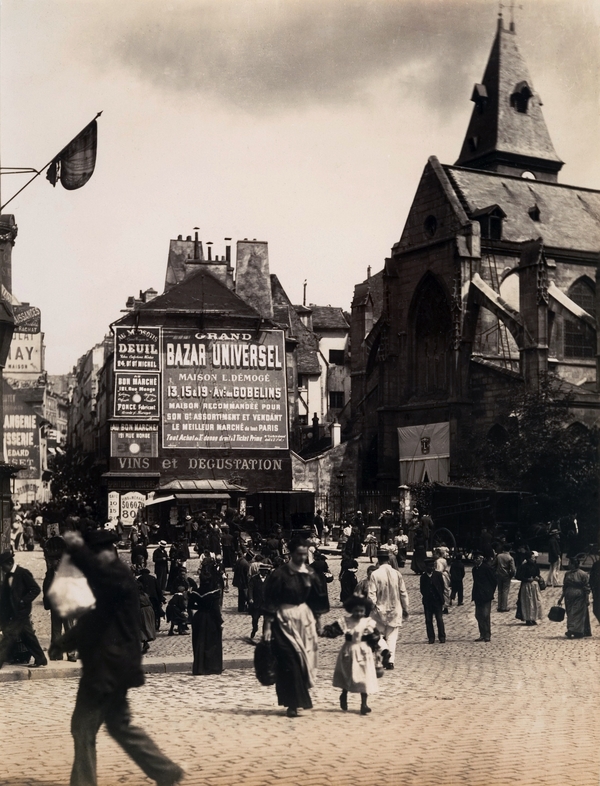Last Updated on December 19, 2025 by Emma Fajcz | Published: August 27, 2019
To wander through rue Mouffetard is to walk through Parisian history.
One thing is certain: there is no shortage of beautiful streets in Paris. But one tiny street stands out among the rest: rue Mouffetard. As the oldest street in Paris, it exudes unparalleled charm and personality. If you’d like to experience the authentic Parisian atmosphere, this is the right place to be.

Rue Mouffetard in the Past
Tucked away in the heart of the Latin Quarter, rue Mouffetard has stood here since Roman times. In fact, it’s a remnant of a road that used to lead all the way to Rome! The first stones of the rue Mouffetard were laid down by Roman legionnaires more than 2,000 years ago.
Paris as we know it today started taking shape in the 19th century, after Baron Haussmann’s full-scale remodeling of the city. Medieval streets and houses, deemed overcrowded and unhealthy, were replaced by modern buildings, avenues and squares. In a matter of decades, medieval Paris all but completely disappeared.
Rue Mouffetard escaped the fate of most Parisian streets. Haussmann decided not to include it in his redevelopment, as it laid nestled at the foot of Mont Sainte-Geneviève with the Panthéon at the top of the hill. Still, rue Mouffetard was shortened to allow for the expansion of the nearby Avenue des Gobelins. Only about 600 meters of the old road remain.
The name Mouffetard comes from mouffette, the French word for “skunk.” In the 18th century, rue Mouffetard was the prime location for animal skinners, filled with the overwhelming stench of rot and decay, hence its name. Throughout the years the street was called Montfétard, Maufetard, Mostard and even Rue Saint-Marcel, Rue du Faubourg Saint-Marceau and Rue de la Vieille Ville Saint-Marcel. Finally, it became rue Mouffetard—or “la Mouffe,” as locals prefer to call it.

Rue Mouffetard Today
With its cobblestone pavement, intact medieval houses and the old St. Médard church, rue Mouffetard transports you into another world. Many of the buildings date from as early as the 11th century and are listed as historical monuments. It’s no wonder that the special ambiance of rue Mouffetard served as an inspiration to some famous literary names, such as Victor Hugo as he was writing “Les Misérables.”
Rue Mouffetard is the ideal place for a leisurely stroll among old bars, family-run cafés and markets. The best time to visit is on the weekends when the street is busy with locals doing their grocery shopping and meeting friends for lunch or coffee.
On Sunday afternoons, as tradition dictates, everyone flocks to the square in front of the St. Médard church at the southern end of the street. Parisians of all ages gather to dance and sing classic French chansons, accompanied by the accordion—an experience that you should not miss.

Rue Mouffetard: The Market Street
Rue Mouffetard was a major market street already in the Middle Ages, when farmers from agricultural areas around Paris would come here to sell their products.
Today, rue Mouffetard houses one of the city’s most popular street markets. Hemingway, who used to live at number 74, described it in “A Moveable Feast” as a “wonderful, narrow crowded market street.” The lower part of rue Mouffetard, lined with colorful stalls of fruit and vegetables, is still a true feast for the senses.
Further up the street, towards Place de la Contrescarpe, you’ll find several outstanding delis selling local specialties like cheese, seafood, meat, wine, bread and pastry. Don’t miss Androuet, one of the best fromageries in Paris, offering no less than 200 types of cheese. As you enter, be sure to look up to admire the beautiful original painted exterior of the building. For your sweet tooth, visit Mococha where three famous master chocolatiers create the most exquisite Parisian chocolates.

5 Must-Try Restaurants in Rue Mouffetard
For an authentic, local experience, head to one of the many restaurants serving traditional French fare.
- Le Verre a Pied, famous for its appearance in “The Fabulous Destiny of Amélie Poulain,” is a typical family-owned Parisian bistro. The locals’ favorite dish is the rabbit leg in mustard.
- Le Vieux Chêne is one of the oldest bars in Paris, dating back to the 18th century. Take a look at the wooden carving of a tree outside before you get immersed into its old-fashioned atmosphere.
- L’assiette aux Fromages specializes in delectable cheese-based classics such as raclette and cheese fondue.
- Le Jardin d’Artemis is a bistro offering a small menu of fine French cuisine. Try the escargot with fine herbs and the crème brûlée for dessert.
- Cave La Bourgogne is a laid-back brasserie serving simple traditional meals. On the menu, you’ll find dishes like duck confit and steak au poivre (pepper steak).








